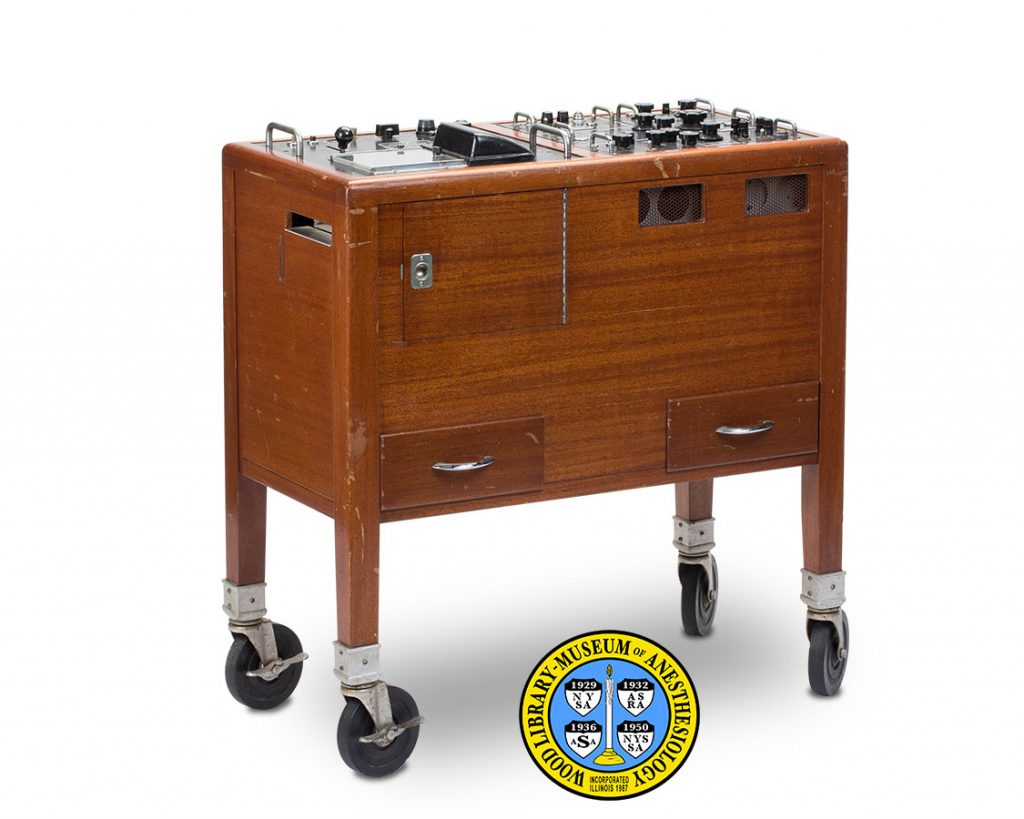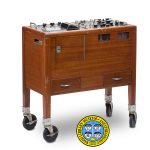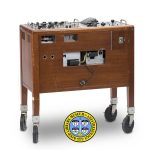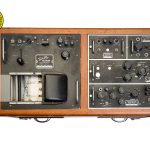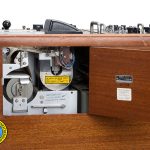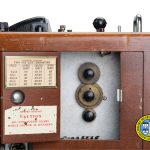Sanborn Twin Viso Recorder
Anesthesiologists are responsible for maintaining the patient's vital functions during surgery, including monitoring of the heart and, when necessary, performing cardiac resuscitation. The abbreviations ECG and EKG are used interchangeably to mean both "electrocardiograph" and "electrocardiogram". An electrocardiograph is an instrument that displays, and records, a graphic representation of the heart's electrical activity. An electrocardiogram is the graphic tracing of that activity.
Founded in Boston in 1917, Sanborn Company made electrocardiographs and other medical apparatus. One of its many EKG machines was the Twin-Viso Recorder, marketed in various models from the early 1950s through the mid-1960s. The machine could record two different aspects of the heart's activity simultaneously. Both tracings were produced on a plastic-coated roll of paper using a heated stylus. The example shown here is a Twin-Viso Model 60-1300.
Catalog Record: Sanborn Twin Viso Recorder Sanborn Twin Viso
Access Key: aqld
Accession No.: Needs Number
Title: Sanborn Twin-Viso Recorder / Sanborn Company.
Corporate Author: Sanborn Company.
Title variation: Alt Title
Title: Sanborn electrocardiograph.
Publisher: Waltham, Massachusetts : Sanborn Company, [between 1958 and 1965].
Physical Description: 1 electrocardiograph : metals, plastics, rubber, wood ; 86 x 94 x 63.5 cm. Waltham, Massachusetts : Sanborn Company, [between 1958 and 1965].
Note Type: General
Notes: The first year in the date range is based on the label on one of the machine’s components, dated “7/58”. The second year in the date range is based on the maintenance service label, dated “2-11-65”.
Note Type: With
Notes: Numerous small objects were found in the drawers.
Note Type: Citation
Notes: ECG Library webpage. http://www.ecglibrary.com/ecghist.html. Accessed June 1, 2017.
Note Type: Citation
Notes: Hewlett Packard Sanborn Division. 60-1300, 60-1300B, Sanborn Twin-Viso Recorder Operating and Service Manual. Waltham, MA: Hewlett Packard Sanborn Division, 1966.
Note Type: Citation
Notes: Hewlett-Packard website. http://www8.hp.com/us/en/hp-information/about-hp/history/hp-timeline/timeline.html. Accessed Jun 7, 2017.
Note Type: Citation
Notes: Sanborn Company. Bulletin 2: Sanborn Two-Channel Recording System (Twin-Viso) Model 60. Cambridge, MA: Sanborn Company, November, 1952.
Note Type: Citation
Notes: Sanborn Company. Twin-Viso Recorder Model 60-1300 Instruction Manual. Waltham, MA: Sanborn Company, ca. 1960.
Note Type: Citation
Notes: The Science Museum website. http://collection.sciencemuseum.org.uk/objects/co94261/twin-viso-electrocardiograph-machine-with-power-su-electrocardiograph-machines. Accessed June 1, 2017.
Note Type: Citation
Notes: U.S., National Institutes of Health, Office of History, Trade Catalogs web page. https://history.nih.gov/museum/catalogss.html. Accessed June 2, 2017.
Note Type: Physical Description
Notes: The dimensions in the short description give the height with the plastic window standing upright, and the depth with the paper drive access door standing open; The height of the cabinet with the plastic window closed is 33.5 centimeters; The depth of the cabinet with the paper drive access door closed is 43.5 centimeters; According to the manufacturer’s product literature, the cabinet is made of mahogany; It is mounted on four rubber wheels;
The top of the cabinet is divided into three bands; The top band consists of two separate panels; The middle and lower bands each consist of only one panel; Each panel is held in place by thumbscrews, and has two metal handles which are mounted at the left and right edges of the panel; Each panel can be lifted out by these handles for servicing, and/or to change one of the interchangeable amplifiers or preamplifiers; A larger handle is mounted on the top near the upper left corner, and another is mounted on the top near the lower right corner; These larger handles can be used to move the apparatus;
The left-hand panel of the upper band holds 13 components, roughly arranged in three rows; One of these is a transparent plastic door that allows access to the recorder; The label plate on this panel reads: “TWIN-VISO [new line] RECORDER [new line] SANBORN [Registered symbol] COMPANY [new line] WALTHAM, MASS., U. S. A. [new line] MODEL 60-1300 SERIAL 555 VOLTS 115 CYLCES 60 AMPS 2”;
The right-hand panel in the upper band holds seven components; The label plate of this panel reads: “POWER SUPPLY [new line] SANBORN [Registered symbol] COMPANY [new line] WALTHAM, MASS., U. S. A. [new line] MODEL 60-1000 [new line] SERIAL 1362”;
The panel that makes up the middle band holds nine components, roughly arranged in three rows; The label plate of this panel reads: “ECG PREAMP [new line] SANBORN [Registered symbol] COMPANY [new line] WALTHAM, MASS., U. S. A. [new line] MODEL 60-200 SERIAL 849”;
The panel that makes up the lower band holds nine components, arranged roughly in four groups from left to right; The label plate of this panel reads: “D. C. AMPLIFIER; SANBORN [Registered symbol] COMPANY [new line] WALTHAM, MASS., U. S. A. [new line] MODEL 64-3003 SERIAL 1300”.
The front of the cabinet holds an access door, two ventilating ports and two drawers; The door is opened by an inset ring pull; The inner side of this door has a label plate that reads: “SANBORN [Registered symbol] COMPANY [new line] WALTHAM, MASS., U. S. A. [new line] MODEL 60-1400 [new line] SERIAL 1792”; Below this plate the door is stamped in black ink: “GR 7797”; Below this stamp there is an adhesive sticker that reads: “HEWLETT-PACKARD CO. [new line] SOUTHERN SALES DIVISION [new line] ATLANTA, GA. [new line] PHONE (404) 233-1141 [new line] SERVICED 2-11-65 BY EEB”; The date and initials are hand-written in ink;
Three parts of the paper drive are marked; The spool support bracket is stamped with the number “2”; One component is labeled: “IMPORTANT [new line] REMOVE SCREW [new line] BEFORE TURNING HANDLE”; Another component is labeled: “THE ARNOLD ENGINEERING COMPANY [new line] PART # 7814 SERIAL # 6911 [new line] GAUSS READING 8497 DATE 7-58”;
The paper record emerges through the paper discharge slot on the left side of the cabinet; There are two ventilation ports on the right side of the cabinet, and one on the back of the cabinet; The back holds various sockets, electrical cords and cables; A small wooden door on the right side of the cabinet give access to the gear assembly; There are two labels on the inner side of this door; One is an adhesive label that reads: “SANBORN COMPANY [new line] CAUTION [new line] DO NOT TOUCH GEARS [new line] WHILE MOTOR IS RUNNING [new line] ENG 17”; The other is a card inserted in a metal bracket; This card reads, in part: “SANBORN COMPANY [new line] TWIN VISO GEAR COMBINATIONS [new line] SPEED, LOWER SHAFT, CENTER SHAFT”, UPPER SHAFT”.
Note Type: Reproduction
Notes: Photographed by Mr. Steve Donisch, June 21, 2017.
Note Type: Historical
Notes: Anesthesiologists are responsible for maintaining the patient’s vital functions during surgery, including monitoring of the heart and, when necessary, performing cardiac resuscitation. The abbreviations ECG and EKG are used interchangeably to mean both “electrocardiograph” and “electrocardiogram”. An electrocardiograph is an instrument that displays, and records, a graphic representation of the heart’s electrical activity. An electrocardiogram is the graphic tracing of that activity.
Sanborn Company was founded in Boston, Massachusetts in 1917, and made electrocardiographs and other medical apparatus. By 1935, the company had relocated to Cambridge, Massachusetts, which was home to another maker of electrocardiographs, Cambridge Instrument Company. By 1956 Sanborn had moved again, to Waltham, Massachusetts, where the cataloged object was manufactured. It is an example of the Twin-Viso Recorder Model 60-1300. The Model 60 was marketed in 1952, and continued to be available in various modifications after Sanborn became a division of Hewlett Packard in 1961. A maintenance label shows that the cataloged object was serviced by Hewlett-Packard in 1965.
The manufacturer described the Model 60 as “a two channel direct-writing amplifier-recording system with each channel operating entirely independently of the other but both registering phenomena simultaneously on the recording paper in true rectangular coordinates, and by a heated stylus” (1952). Another description states: “A third stylus records either one second timing impulses, or marker traces to identify phenomena of particular interest” (1966).
Note Type: Exhibition
Notes: Selected for the WLM website.
